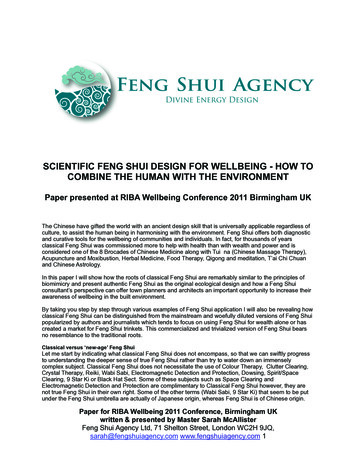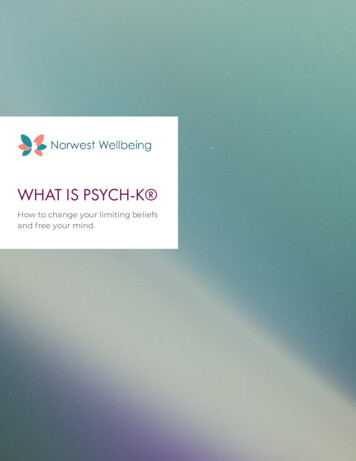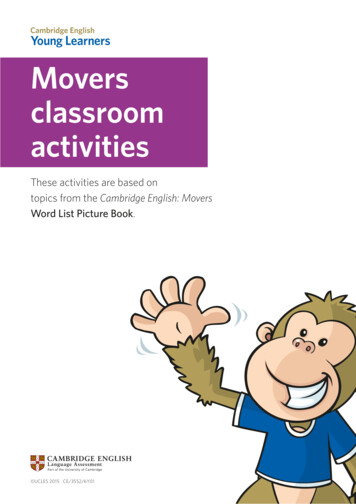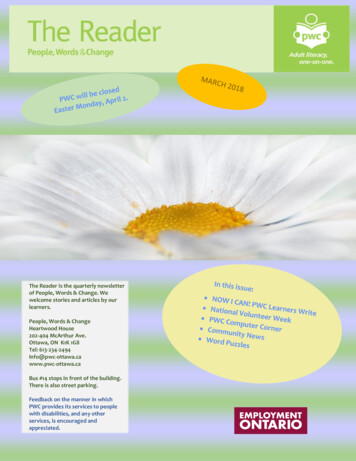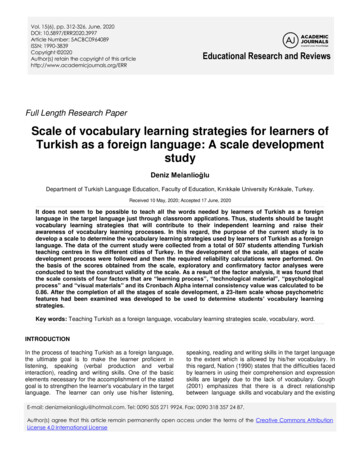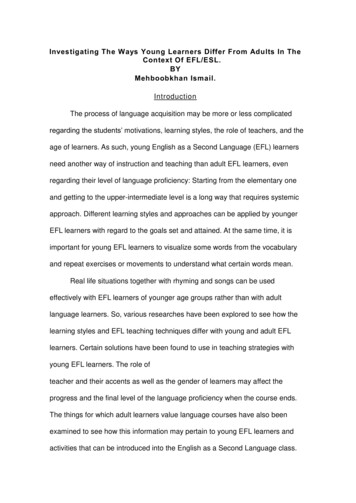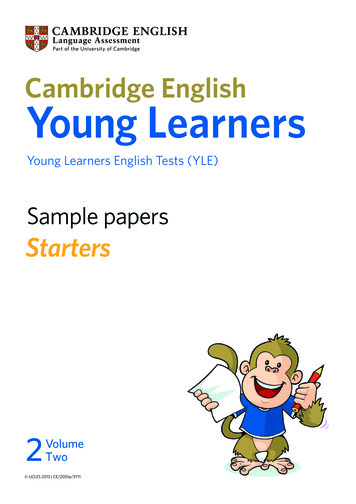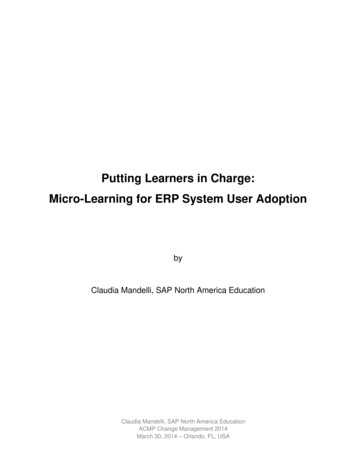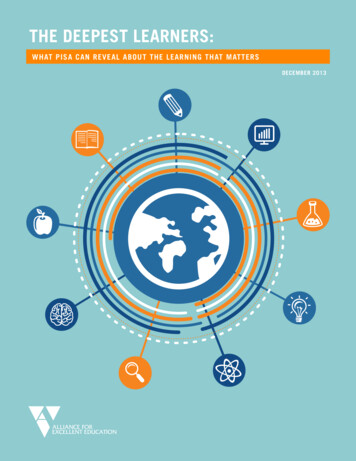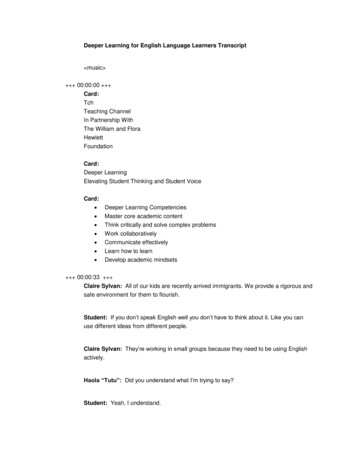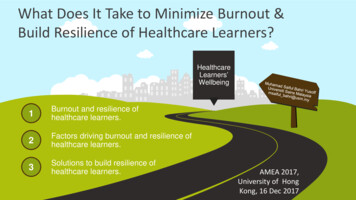
Transcription
What Does It Take to Minimize Burnout &Build Resilience of Healthcare Learners?HealthcareLearners’Wellbeing1Burnout and resilience ofhealthcare learners.2Factors driving burnout and resilience ofhealthcare learners.3Solutions to build resilience ofhealthcare learners.AMEA 2017,University of HongKong, 16 Dec 2017
Majority of burnout reports among learnersin higher education were from US & EuropeSystematic Review & Meta-AnalysisNorth AmericaEurope (UK, Turkey, Spain, Serbia,Netherland, Georgia, Germany, Slovakia)43.2%37.8%16.2%(US)2.8%Asia-Pacific (China, HongKong, Malaysia, Australia)South America (Brazil)(Yusoff, 2017)
Studies were predominantly carried outon healthcare learners48.7% Medical Students12.9% Nursing Students10.3% Dental Students07.8%Veterinary, PhysicalTherapy & PsychologyStudents20.7% Non-HealthcareLearners(Yusoff, 2017)
Burnout was predominantlymeasured by MaslachBurnout Inventory42.1%Maslach BurnoutInventory28.9%Maslach BurnoutInventory – HumanService Survey10.6%Maslach Burnout Inventory– Student Survey18.4%Others: Oldenburg Burnout Inventory,Copenhagen Burnout Inventory, StudentBurnout Inventory, Professional Quality Of Life(Yusoff, 2017)
Burnout mostly relate to the experienceof low personal izationLow PersonalAccomplishment43.3%30.7%28.3%44.5%(24.9%, 31.9%)(26.9%, 63.6%)(38.6%, 48.1%)(27.8%, 33.9%)(Yusoff, 2017)
53%The pattern ofburnout peaksat the secondyear of study,and decreasestoward the finalyear of study.43%41%26%37%(Yusoff, 2017)
60%20%Low AcademicPerformanceDepression andSuicidal Ideation40%80%Decreased Empathy& AccountabilityUnprofessionalBehaviorsBurnout lead to many negative ramifications(Schaufeli, Leiter, & Maslach, 2009; Dyrbye & Shanafelt, 2016; Yusoff, 2017)
37% are RESILIENCEVULNERABLETO BURNOUTEXPERIENCEBURNOUT BURNOUT20%37%(Dyrbye et al, 2010)
What drive burnout and resilience?Vulnerable toBurnout64%54%Develop Burnout43%37%Recover fromBurnoutExperience BurnoutResilience20%(Dyrbye et al, 2010; Yusoff, 2017)
Six Main Drivers of Burnout and servoirMotivationSocialPsychological(Yusoff, 2017)
AcademicPositive Input (replenish theNegative Input (deplete thecoping reservoir to handle challenges)coping reservoir to handle challenges)Flexibility & student involvementCourse load (Yang, 2004;Pohlmann, 2005)(Neumann et al., 1990)Hospital ward rotation, overnightcall & placement hassles (Dyrbye etPositive attitude & feelingtoward study (Cazan, 2015)al., 2009; Gibbons, 2010)Workload (Atalayin et al., 2015;Support uplifts (Gibbon, 2010)Pohlmann, 2005)Dissatisfaction with learningsupport (Dyrbye et al., 2009;Academic satisfaction(Atalayin et al., 2015)Chang et al., 2015)Course organization, teaching &learning hassles (Gibbons, 2010)Positive learning climate(Dyrbye et al., 2009)Resilience Burnout
PersonalNegative Input (deplete thePositive Input (replenish thecoping reservoir to handle challenges)coping reservoir to handle challenges)Positive life events (Dyrbye etNegative life events (Dyrbyeal., 2009, 2010; Capri et al., 2012)et al., 2006; Dyrbye et al, 2009)Intention to leave the course orprofession (Dyrbye et al., 2009; Moneta,Self-efficacy (Neumann, 1990; Yang,2004; Gibbons, 2004; Yang et al., 2005,Cazan, 2015)2011)Commitment & compassionLack of confidence in skills(Neumann, 1990; Kyeong, 2013)(Chang et al., 2015)Dispositional control, self-esteem& self-oriented perfectionismThe choice of a specialtywith a high income (Enoch et(Gibbons, 2010; Skodova, 2013; Chang etal, 2015)Vacation days (HowardHamilton et al., 1998)al., 2013)Negative self-judgment – beingharsh to self in time of suffering(Beaumont, 2016)Resilience Burnout
PsychologicalNegative Input (deplete thePositive Input (replenish thecoping reservoir to handle challenges)coping reservoir to handle challenges)Psychological wellbeing - lessstress (Dyrbye et al., 2010; Kyeong, 2013)Unfavorable stress (Watsonet al., 2008)Less fatigue (Dyrbye et al., 2010)Emotional intelligence (Cazan, 2015)Psychological need satisfaction– autonomy, competence &relatedness (Sulea et al., 2015)High sleep quality (Rella et al., 2008)Resilience Burnout
SocialNegative Input (deplete thePositive Input (replenish thecoping reservoir to handle challenges)coping reservoir to handle challenges)Social support (Dyrbye et al., 2010;Lack of social integration &competence (Pohlmann et al., 2005)Yeang, 2004; Yang & Farn, 2005)Engage with social activitiesIn an unhealthy relationship(Fares et al., 2016)(Fares et al., 2016)Living with relative (Fares et al.,Music-related activities2016)(Fares et al., 2016)Socially prescribedperfectionism (Chang et al., 2015)Femininity – sex-role socialization(Atalayin et al., 2015)Living away from family (Atalayin etal., 2015)Resilience Burnout
MotivationNegative Input (deplete thePositive Input (replenish thecoping reservoir to handle challenges)coping reservoir to handle challenges)Intrinsic motivation (Pisarik, 2009)Amotivation & external regulationNeed for achievementLow motivation to learning (Tukaev(Pisarik, 2009)(Moneta, 2011)et al., 2013)Extrinsic motivation (Chang et al.,Learning motivation (Cazan, 2015)2015)Resilience Burnout
Coping StrategiesNegative Input (deplete thePositive Input (replenish thecoping reservoir to handle challenges)coping reservoir to handle challenges)Task-oriented copingEmotion-oriented coping(Watson et al., 2008)(Watson et al., 2008)Avoidance coping (Gibbons, 2010)Resilience Burnout
How to build resilience &minimize burnout?BreakReadyAction
Student Development Strategies to Build ResilienceDetection skillsEarly detection of thepositive & negative inputs01Evaluation skillsSystematic evaluation ofthe positive & negativeinputs0204Develop social competenceDevelop social competence to increasesocial integration and support03Develop coping abilityDevelop positive coping strategies tohandle challenges(Bugaj et al, 2016; Skodova & Lajciakova, 2013; Yusoff, 2014)
Special interventions improve psychological healthPsychosocialTrainingModerateEffectSizeThe DEALBased PracticeMindfulness-BasedStress ReductionSupportGroup(Bugaj et al, 2016; Skodova & Lajciakova, 2013; Yusoff, 2014)
Faculty Strategies to Improve ResilienceCurriculum DesignLearning MilieuStudent SupportTeaching & SupervisionSampletext A wellness curriculumLearning activitiesAssessment for learningLearning support systemEffective feedback forlearning Flexibility & engagement Promote group & socialsupport through small grouplearning Healthy & positive learningenvironment Improve Access to personalcare and help-seeking Peer-mentoring Faculty-learner mentoring Reduce stigma towardmental health problems Minimize barriers to helpseeking Effective teaching &supervisory skills(Yusoff, 2017)
The StudentMedical & Academic Response Team dsof ctionSTEPSDeputy Dean Academic/Chairperson of Student Personal& Development/Curriculum Committee MembersStudent AffairOfficeMentorCounselorPsychologist*STEPS: Simplified Thematic Engagement of Professionalism Scales- A summative-formative assessment tool incorporated in the logbook toassess professionalism longitudinally.MedicalPhysician(Yusoff, 2017)
Final Thoughts01020304A high prevalence ofburnout amonghealthcare learnersHealthcare learnerspredominantlyexperienced sense of lowpersonal accomplishmentAcademic, personal &psycho-social are themain drivers ofresilience & burnoutBuilding resilience shouldbe done collaborativelyvia individual-institutionalstrategies
THANK YOUThis presentation can be downloaded fromhttps://tinyurl.com/y7wlbnhoMuhamad Saiful Bahri Yusoff, MD, MMEd, PhDDepartment of Medical Education, School of Medical Sciences,Universiti Sains Malaysia, msaiful bahri@usm.my
Dental Students . Veterinary, Physical Therapy & Psychology Students . Non-Healthcare Learners . Promote group & social support through small group learning Healthy & positive learning . Muhamad Saiful Bahri Yusoff, MD, MMEd, PhD . Departm
